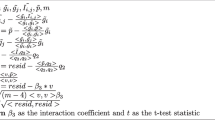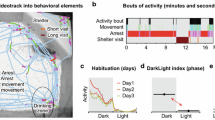Abstract
A number of quantitative trait loci (QTLs) recently have been discovered that affect various activity traits in mice, but their collective impact does not appear to explain the consistently moderate to high heritabilities for these traits. We previously suggested interactions of genes, or epistasis, might account for additional genetic variability of activity, and tested this for the average distance, duration and speed run by mice during a 3 week period. We found abundant evidence for epistasis affecting these traits, although, recognized that epistatic effects may well vary within individuals over time. We therefore conducted a full genome scan for epistatic interactions affecting these traits in each of seven three-day intervals. Our intent was to assess the extent and trends in epistasis affecting these traits in each of the intervals. We discovered a number of epistatic interactions of QTLs that influenced the activity traits in the mice, the majority of which were not previously found and appeared to affect the activity traits (especially distance and speed) primarily in the early or in the late age intervals. The overall impact of epistasis was considerable, its contribution to the total phenotypic variance varying from an average of 22–35% in the three traits across all age intervals. It was concluded that epistasis is more important than single-locus effects of genes on activity traits at specific ages and it is therefore an essential component of the genetic architecture of physical activity.

Similar content being viewed by others
References
Cheverud JM (2001) A simple correction for multiple comparisons in interval mapping genome scans. Heredity 2:52–58
Cheverud J, Vaughn T, Pletscher L, Peripato A, Adams E, Erickson C, King-Ellison K (2001) Genetic architecture of adiposity in the cross of large (LG/J) and small (SM/J) inbred mice. Mamm Genome 12:3–12
Holland JB (1998) EPISTACY: a SAS program for detecting two-locus epistatic interactions using genetic marker information. J Hered 89:374–375
Houle-Leroy P, Garland T Jr, Swallow JG, Guderley H (2000) Effects of voluntary activity and genetic selection on muscle metabolic capacities in house mice M. domesticus. J Appl Physiol 89:1608–1615
Kas MJH, de Mooij-van Malsen JR, de Krom M, van Gassen KLI, van Lith HA, Olivier B, Oppelaar H, Hendriks J, de Wit M, Groot Koerkamp MJA, Holstege FCP, van Oost BA, de Graan PNE (2009) High-resolution genetic mapping of mammalian motor activity levels in mice. Genes Brain Behav 8:13–22
Leamy LJ, Pomp D, Lightfoot JT (2008) An epistatic genetic basis for physical activity traits in mice. J Hered 99:639–646
Leamy LJ, Pomp D, Lightfoot JT (2010) A search for quantitative trait loci controlling within-individual variation of physical activity traits in mice. BMC Genet 11:83
Lerman I, Harrison BC, Freeman K, Hewett TE, Allen DL, Robbins J, Leinwand LA (2002) Genetic variability in forced and voluntary endurance exercise performance in seven inbred mouse strains. J Appl Physiol 92:2245–2255
Li J, Ji L (2005) Adjusting multiple testing in multilocus analyses using the eigenvalues of a correlation matrix. Heredity 95:221–227
Lightfoot JT, Turner MJ, Daves M, Vordermark A, Kleeberger SR (2004) Genetic influence on daily wheel running activity level. Physiol Genomics 19:270–276
Lightfoot JT, Turner M, Kleinfehn A, Jedlick A, Oshimura T, Marzec J, Gladwell W, Leamy L, Kleeberger S (2007) Quantitative trait loci (QTL) associated with maximum exercise endurance in mice. J Appl Physiol 103:105–110
Lightfoot JT, Turner MJ, Pomp D, Kleeberger SR, Leamy LJ (2008) Quantitative trait loci for physical activity traits in mice. Physiol Genomics 32:401–408
Nehrenberg DL, Wang S, Hannon RM, Garland T Jr, Pomp D (2010) QTL underlying voluntary exerercise in mice: interactions with the “mini-muscle” locus and sex. J Hered 101:42–53
Peripato AC, de Brito RA, Matioli SR, Pletscher LS, Vaughn TT, Cheverud JM (2004) Epistasis affecting litter size in mice. J Evol Biol 17:593–602
Storey JD, Tibshirani R (2003) Statistical significance for genome-wide studies. PNAS 100:9440–9445
Wolf JB, Leamy LJ, Routman EJ, Cheverud JM (2005) Epistatic pleiotropy and the genetic architecture of covariation within early and late-developing skull trait complexes in mice. Genetics 171:683–694
Yang HeS, Vitaterna MH, Laposky AD, Shimomura K, Turek FW (2009) Genetic analysis of daily physical activity using a mouse chromosome substitution strain. Physiol Genomics 39:47–55
Acknowledgments
We should like to thank two anonymous reviewers for excellent revision suggestions on an earlier version of this paper. This work was supported in part by grants from the National Institutes of Health (NIDDK DK61635 to J. Timothy Lightfoot, NIAMS AR050085 to J. Timothy Lightfoot and Larry J. Leamy, and NIDDK DK076050 to Daniel Pomp).
Author information
Authors and Affiliations
Corresponding author
Electronic supplementary material
Below is the link to the electronic supplementary material.
Rights and permissions
About this article
Cite this article
Leamy, L.J., Pomp, D. & Lightfoot, J.T. Epistatic interactions of genes influence within-individual variation of physical activity traits in mice. Genetica 139, 813–821 (2011). https://doi.org/10.1007/s10709-011-9586-9
Received:
Accepted:
Published:
Issue Date:
DOI: https://doi.org/10.1007/s10709-011-9586-9




